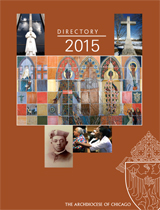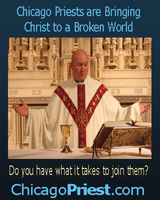Bone tour ends with
Mass for ‘citizen saint’
Dem bones, ‘dem bones.
We Catholics have a tradition of venerating them.
Ones of saints, that is. Over the centuries, various faiths — including Catholicism — have venerated relics, or objects related to deceased holy people, as a way of remembering the person and inspiring personal belief. They are part of what the Catechism of the Catholic Church calls “expressions of piety [that] extend the liturgical life of the church but do not replace it” (No. 1675).
For the past six months, the arm bone of Chicago’s own “citizen saint,” Mother Frances Xavier Cabrini, has made its way around to a half dozen area churches. Next month, the faithful will join Cardinal George in marking the end of this pilgrimage and the 90th anniversary of Mother Cabrini’s death at an 11 a.m. liturgy Dec. 22 at the Shrine of Our Lady of Pompeii, 1224 W. Lexington St.
Other stops on the “Walking With a Saint” tour included the parishes of Our Lady of Guadelupe, St. Mary of Celle, St. Rita of Cascia, St. Paul of the Cross and St. Agnes of Bohemia. The Shrine of Our Lady of Pompeii and the Missionary Sisters of the Sacred Heart of Jesus sponsored the tour. Mother Cabrini’s relic is permanently housed at the National Shrine of St. Frances Cabrini, which currently is closed for construction.
Born in 1850, Mother Cabrini founded the Missionary Sisters of the Sacred Heart of Jesus in her native Italy at the age of 30, and later came to the United States to care for poor children by founding schools, hospitals and orphanages. Chicago’s Columbus and Cabrini hospitals were two of 67 schools, orphanages and hospitals that she founded during her 30 years working with Italian immigrants who were then pouring into the United States, according to the Chicago-based Mother Cabrini League.
At the time of her death in 1917, Mother Cabrini had nuns teaching at Assumption School just north of the Loop and even sent Irish nuns to teach Irish immigrants in Argentina.
“We have been international for a long time,” said Sister Joan McGlinchey, Chicago archdiocesan vicar for religious and a member of Mother Cabrini’s congregation. “Today we have a mission in Siberia and recently professed seven new nuns in Ethiopia. And we still have two high schools and a college here in the U.S.”
Pope Pius XII canonized Mother Cabrini in 1946 — a mere 29 years after her death — and five years later she was proclaimed patron of immigrants. Since she was a U.S. citizen at the time of her death, the teaching sister became the first American to become a saint.
Here in Chicago, she did a lot of work on the Near West Side and founded the nearby Columbus Extension, later named Cabrini Hospital. When she didn’t worship in the chapel at Columbus Hospital, where she lived and died, she often attended mass at nearby St. Clement Church, McGlinchey said.
The National Shrine of St. Frances Cabrini was built around the room where she died. In what is perhaps a strange turn of events but part of modern growth, the shrine is expected to reopen in three years within a luxury condominium building.
When Columbus Hospital closed and a developer bought the property to build the condos, it was agreed that the room where Mother Cabrini would be preserved and space allotted for the shrine’s ministry.
When it reopens, it just may be the only shrine of its kind in the world, McGlinchey said.
“They’ll build a new entrance for us with some program space,” she said. “And yes, it’s very unusual to have a national shrine to a saint in the middle of a high-end condo project.”
'Separated parts'
Body parts of St. Frances Xavier Cabrini are scattered around the world. Mother Cabrini’s arm bone is here in Chicago.
Several body parts including the arm bone were removed when Mother Cabrini’s remains were exhumed in 1938 during the canonization investigation, Sister Joan McGlinchey, Chicago archdiocesan vicar for religious and a member of Mother Cabrini’s congregation said.
In the past, it wasn’t uncommon for the faithful to venerate bones of saints. These days it is more common to keep the remains of the body intact and instead use hair or possessions of the saints, such as pieces of clothing, for veneration.
Mother Cabrini’s skull went to a church she founded in Rome; her heart went to Cadonia, Italy, where she started her order; and her trunk was encased in a wax effigy in a New York church, McGlinchey said.
Other bones, hair and nails can be seen in missions she started in Guatemala, Nicaragua, Argentina, Spain, South Africa and Australia.
“Cardinal [Samuel] Stritch regretted letting the body go to New York to be buried, but they did what they did in Europe. They separated the parts,” McGlinchey said. “We don’t see much of that done here. But relics have been a way of connecting with a saint’s life. We gave Cardinal George a lock of her hair.”
 Catholic
New World - Newspaper for the Archdiocese of Chicago
Catholic
New World - Newspaper for the Archdiocese of Chicago Archdiocese of Chicago Directory
Archdiocese of Chicago Directory Oficjalne wydawnictwo Archidiecezji Chicago w języku polskim
Oficjalne wydawnictwo Archidiecezji Chicago w języku polskim